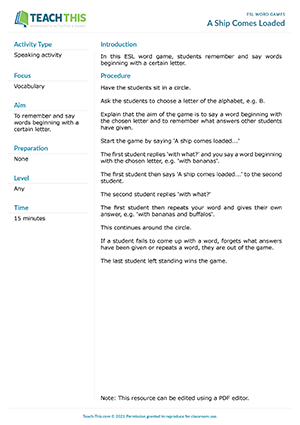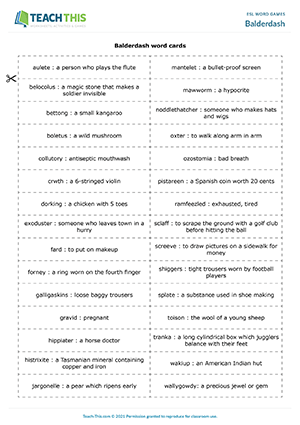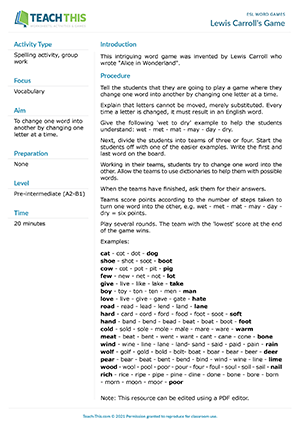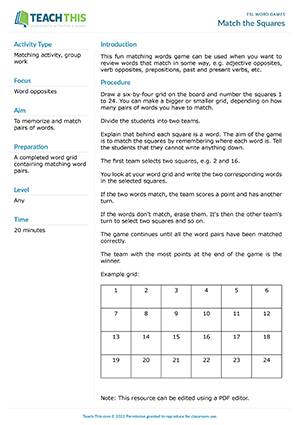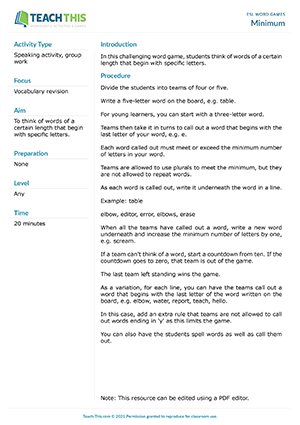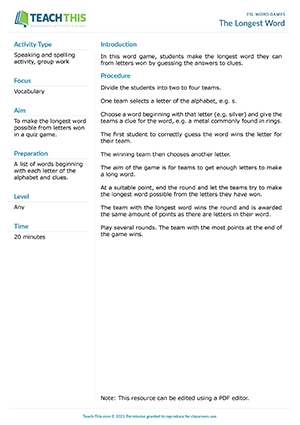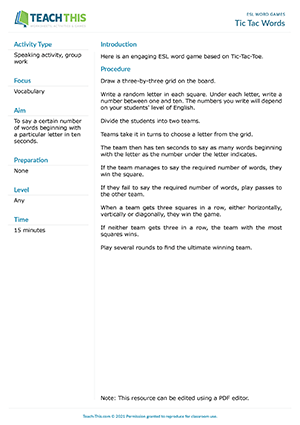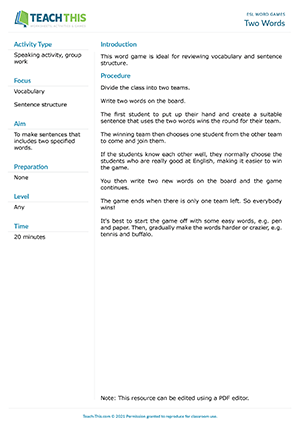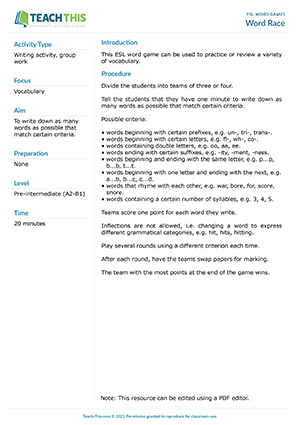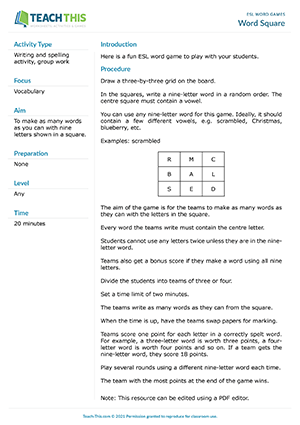If you’re teaching writing and are looking for some of the best ESL writing activities, along with worksheets, lesson plans and more then you’re in the right place. Keep on reading for everything you need to know about teaching English writing.
ESL writing exercises and games
Let’s check out the top ESOL writing exercises and activities to consider trying out with your students.
Are you ready to get into the ESL writing exercises? Then let’s get to the best English writing ideas. Also, check out some great writing prompts ideas to use in your writing lesson.
#1: 3 Things ESL Writing Activity
I’m ALL about simple and easy for writing activities in emergency situations when you don’t have a lot of time to prep. 3 Things is ideal because it requires nothing except a pen and paper and also requires no prep time.
The way it works is that students think of 3 random things. Then, they give those words to a partner who has to write a short story using them. It can be serious or silly and kind of depends on the words chosen.
Do you want to give it a try with your students? Check out all the details here: 3 Things English Writing Activity.
#2: Journaling for English Learners
When I teach ESL writing classes, I always have students keep a journal. It can either be with pen and paper or online. It’s a fun way for students to work on writing fluency and have some freedom to write about topics they want to write about, not just the ones that I assign.
If you want to see how I set up this ESL writing exercise, check out the following: Journaling for ESL Students.
#3: Postcards ESOL Writing Exercise
If you’re looking for a simple, fun ESL writing activity, then you may want to consider having your students write some postcards. Ideally, you could get your hands of a stack of blank, unused postcards. But, if not, students can design their own and then trade with someone else who can fill in the back.
Learn more about this fun writing activity here: ESL Postcard Writing Activity.
#4: A to Z Alphabet Game
Remember that writing is more than a 5-paragraph essay. It’s any time a student is writing something, even one word. With that in mind, you may want to try out this ESL writing game for beginners.
The way it works is that you name a topic. Jobs or animals for example. Then, students have to think of one word for each letter. I give my students a certain amount of time and the team with the most words is the winner.
Do you want to give this writing activity for beginners a try? Check it out here: A-Z ESL Writing Activity.
#5: Conjunctions and Transitions
Words like but, so, and, however, etc. are key in English writing because they join ideas, sentences and paragraphs together. This makes writing easier to understand and helps it to flow better. Even beginners can learn about using things like and or but.
Here are some of the ideas for teaching these words: ESL Conjunction and Transition Activities.
#6: Whiteboard Games
I don’t know why, but students really love to write on the whiteboard. There are a ton of relay type ESL writing activities that you can do. Here are some of the best ones:
ESL Whiteboard Activities.
#7: Dictogloss
If you want to challenge your students with some serious listening and writing, then consider this dictogloss ESL activity. The way it works is that you find a passage or write one at an appropriate level for your students.
Then, put the student into pairs and read out the passage at a slightly faster pace than normal. Students have to take notes and then attempt to recreate what they heard by writing. Read the passage again and students add to what they have. Finally, they can compare their version with the original one.
Do you want to give it a try? Read this first: Dictogloss ESL Writing and Listening Activity.
#8: How to Teach English Writing to Beginners
Back when I did the CELTA course, my tutor told me that writing doesn’t have to be a 5 paragraph essay. It can actually be any time the students are writing something in English. With this in mind, here are some of the best activities for absolute beginners to English writing:
Teaching ESL Writing to Beginners.
#9: Fill out an Application Form
One very practical writing activity that we can do with our students is getting them to fill out an application form. If they plan on living in an English speaking country, they’ll certainly have to do this. And, there’s often some very specific vocabulary and expected answers that you can help them with.
More details here: ESL Writing Application Form.
#10: Sentence Structure Activities
In speaking, our students can sometimes get away without having great sentence structure. This is because people often speak in sentence fragments and rarely in full sentences.
However, in writing, sentence structure is key and vital to helping our students get their ideas across on paper. Here are some of the best activities to help our students practice this:
ESL Sentence Structure Games and Activities.
ESL writing games and activities
#11: Is that Sentence Correct?
A simple reading and writing activity is this one that focuses on error correction. The way it works is that you make some sentences, some of which have errors and some that do not. Students have to decide which ones are incorrect and them correct them. It’s ideal for review at the end of class or the beginning of the next one.
Learn more about this writing activity here: ESL Error Correction Activity.
#12: Proof-Reading and Editing
A key part of writing well is proof-reading and editing. Everyone does it, even professional writers! Instead of the students relying on me to correct their errors for them, I like to teach them do to edit their own work. It’s a key skill in the writing process but often overlooked by many English teachers.
Check out this activity for helping students with this writing skill: ESL Proofreading and Editing.
Spending some time working on self-editing skills, instead of relying on the teacher-editing model is a nice way to improve student autonomy in English writing classes.
#13: Focus on Fluency Activity
Many ESL writing textbooks (and teachers too) focus on accuracy in English writing at the expense of fluency. However, both are needed if students are to become proficient in English essay writing. After all, no employer is going to appreciate an employee who can write a simple, but perfect email in half a day! Most would expect it to happen in a few minutes.
Check out this activity to help our students out with this: Fluency ESL Writing Activity.
#14: How to Teach ESL Writing on the Let’s Talk TEFL Podcast
#15: Word Association
I like to use this quick writing activity if I know that students have studied the topic of the day before. For example, jobs and weather are very common in almost all ESL textbooks and if students are at a high-beginner or intermediate level, I guarantee that they already know some of these vocabulary items.
You can find out how to do it right here: ESL Word Association Activity.
#16: ESL Surveys
I love to use surveys in my classes. They are a super versatile activity that covers all 4 skills, including writing. It’s also easy to make a survey for just about any topic or grammar point. See why I love them so much?
If you want to know more, then you’ll want to check this out: TEFL Surveys.
#17: Opinion Activities and Games
Opinion essays are a classic writing activity for both English learners and students in high school or university. That’s why I like to give my students some chances to practice writing and supporting their opinions in my classes. Do you want to try out some of the best ones? You can find out all the details right here:
ESL Opinion Activities.
#18: Parts of Speech Activities for ESL
English writing is ALL about parts of speech. After all, if you don’t know where the verb, subject, object, adjectives and adverbs go, how can you have any chance of making a coherent English sentence? It’s nearly impossible!
That’s why I like to do some worksheets and practice with my students related to this. If you want to try it out too, here are some of the best ideas:
ESL Parts of Speech Activities.
Top 17 ESL writing games and activities
#19: Spelling Challenge Game
Spelling is an important, but often neglected part of writing. In my opinion, it’s worth spending some classroom time on and one way to do that is with this word challenge game. Because it’s done on the whiteboard, it’s ideal for smaller classes.
Want to find out what it’s all about? You can right here: ESL Spelling Challenge Activity.
#20: Dictation
A nice TEFL writing activity that you might want to try out is dictation. It covers not only writing, but also listening, spelling, punctuation, grammar and vocabulary in a big way. Is it obvious why I like it so much?
Try it out with your students today. Learn more here: ESL Dictation Writing Activity.
#21: TEFL Writing Activities and Games
#22: Brainstorm Games and Activities
One of my favourite, simple ESL writing activities is to get students to brainstorm words or things related to a certain topic or category. It’s a nice way to get some creative juices flowing and can also be used for a quick warmer or review activity.
There are a number of engaging, student-centred activities to consider. Here are some of my favourites: Brain Storming Games.
#23: Freeze Writing Activity
Group writing activities for TEFL classes are few and far between. However, freeze is one of the best ones to consider. Students have to work collaboratively to make stories, line by line is a fun and engaging way.
Want to give it a try? Find out how: Freeze Activity.
#24: Five-Paragraph Essay Writing
For higher-level students, it can be a worthwhile activity to teach students how to write academic essays. Here’s an outline and some tips for how to do that:
Five-Paragraph Essay Template.
#25: More Ideas for TEFL Writing
#26: Fill in the Blank Sentences Games
A nice option for beginners in English writing is to use fill in the blanks. This adds a bit of structure to it and makes it much easier for students! Have a look at some of my favourite options:
Fill In The Blank Sentences Games.
#27: Round Robin Story
Try out this simple story writing activity that can be used for speaking & listening, or writing. Learn more:
Round Robin Story.
#28: Five Senses
Try out this simple activity that involves a lot of adjectives. It can be done with speaking or writing.
ESL Writing FAQs
There are a number of common questions that people have about teaching English writing. Here are the answers to some of the most popular ones.
What is ESL Writing?
ESL technically refers to English as a Second Language but the more common usage is anyone who is a non-native speaker of English, whether or not it’s their second, third or fourth language. ESL writing focus specifically on writing skills.
How can ESL Students Improve Writing?
There are a number of ways that ESL students can improve their writing skills:
- Practice, both in class and outside of class is key.
- Give students a reason to write.
- Use peer correction.
- Offer self-editing checklists.
- Give students some freedom to choose what to write about.
- Use a variety of writing activities and games.
- Give students a chance to revise their work based on feedback.
- Strive to make English writing fun and engaging
- Make it relevant to real-life.
- Ensure that your ESL writing classes target the level of the students.
How Can ESL Beginners Learn to Write?
Remember that ESL beginners will not be able to write a 5-paragraph academic essay. Instead, you may want to focus on things like filling in the blanks on a worksheet or writing very simple sentences with a subject, verb, and object.
Why is Writing Difficult for ESL Students?
Writing can be a little bit difficult for ESL students because it not only involves vocabulary and grammar, but things like punctuation, capital letters as well as style and other writing conventions. What does make it easier is that it doesn’t happen in real time like with speaking.
Did you Like these ESOL Writing Exercises?
Yes? Thought so. Then you’re going to love this book you can easily find on Amazon: ESL Writing Activities, Games & Teaching Tips. It’s the first and only ESL activity book dedicated exclusively to teaching writing and it’s a must-have if you’re teaching these kinds of classes.
You can easily get these ESL writing activities in both digital and print formats. Consider keeping a copy on the bookshelf in your office and using it as a handy reference guide. Or, bring the digital version with you on your phone or tablet to your favourite coffee shop for some serious lesson planning for your English writing classes.
It really is that easy to have ESL writing classes! Check out the book on Amazon, but only if you want to get yourself a serious dose of ESL teaching awesome in your life:

Do you Have an ESL Writing Grading Rubric?
If you’re looking for a bit of guidance on how to evaluate your students’ writing, then you’re in the right place. We strongly recommend using a simple rubric that’ll save you a ton of time. Plus, students will understand why they got the grade that they did. All the details can be found here:
ESL Writing Grading Rubric.
ESL Writing Lesson Plans
If you’re looking for some ready-made writing lesson plans that can help your students improve their skills in a big way, you’ll want to check out our top recommendations:
One Stop English
ESL Library
Writing practice for English learners
ESL Writing Worksheets
The good news for English teachers is that there are a ton of English writing worksheets to help you out with just about anything! Why reinvent the wheel if another English teacher has already done the hard work, right? Here are some of the best ESL writing worksheets:
Busy Teacher
ESL Galaxy
ESL Writing Assignments
If you’re not sure about writing assignment options for your ESL/EFL students, here are some of the best ideas that you’ll want to check out:
FluentU
FIS.edu
Consider Investing in Grammarly if you Teach ESL Writing
If you teach English writing, then one of the top tools we can recommend to you is Grammarly. It can help you catch lots of errors that your students are making in their writing. It’s fast and easy to run written assignments through it.
The other reason to consider Grammarly is for the plagiarism checker. It’s a simple way to find out who is actually doing written assignments on their own and who is stealing things from the Internet. Head over there now to find out more about their services:
The World’s Best Automated Proofreader
Have your say about these ESL Writing Activities and Exercises
What do you think about these writing ESL activities? Did you try out one of them from this or have another that you’d like to recommend? Leave a comment below and let us know what you think. We’d love to hear from you.
Also be sure to give this article a share on Facebook, Pinterest, or Twitter. It’ll help other busy English teachers, like yourself find this useful resource for teaching English writing.
Last update on 2022-07-17 / Affiliate links / Images from Amazon Product Advertising API
Writing is one of the four basic English proficiencies next to reading, speaking, and listening. Developing a well-honed ability to write fluidly, naturally, and confidently — while using well-crafted grammatical structure and a wide array of vocabulary — carries several benefits for English learners.
A developed writing ability is essential for scoring well on standardized tests that include essay sections and a well-chosen ESL writing activity can increase the ability to express increasingly complex ideas succinctly and fully, thus improving communication skills across all four proficiencies.
How to Use ESL Writing Activities
As an ESL teacher, part of your teaching scope likely includes improving the writing skills of your students. Fun, engaging activities can be effective tools for achieving the gains in their writing abilities that you hope to see in the classroom.
When to Use ESL Writing Activities
Depending on the type of activity, writing activities can be used:
- At the beginning of a lesson to pique students’ interest and generate excitement about the upcoming lesson.
- Mid-lesson to assess students’ absorption and retention.
- At the conclusion of a lesson to review previously learned vocabulary/grammar.
Setup for ESL Writing Activities
Some ESL writing activities featured here require virtually no setup. Others require a whiteboard and/or projector with computer access. A handful require some preparation before class and pre-printed materials for handout.
Here are a few of the premier ESL writing activities for students divided by age and skill level.
ESL Writing Activities For Young Learners
Flash Card Writing
Young learners are often best engaged with visual cues, so ESL flashcards are great tools for the classroom at the primary level.
To conduct the flash card activity, do a warm-up session by going through each card and, together as a class, writing the correct spelling on the board letter by letter.
Then, heat things up by dividing students into teams and having one member of each team write the vocabulary term on the board as quickly as possible when you prompt them with the corresponding flashcard.
The first student to finish earns a point for his or her team. Incentivize the students, if necessary, with a prize for the team with the most points at the end.
What’s Happening?
Building on the theme of combining imagery with writing for younger ESL learners, consider showing students a picture (the more vibrant, colorful, and detailed, the better) and asking them to write what they see. Consider using images with recently learned phrases as a review method.
Write a Letter to Santa (or Spiderman, Harry Potter, or Whomever)
Letter writing is an essential aspect of a young student’s English. Make it fun by having them write to their favorite superhero, celebrity, or best friend.
If your students need extra guidance, prompt them by suggesting what to write about; if writing to Santa, for example, encourage them to discuss what they would like for Christmas.
Help them frame their letter logically by providing a structure guide and helpful suggestions as necessary.
Postcards to Pen Pals
Capture young learners’ imagination by introducing them to a fictitious young boy or girl (or one inspired by real life) who is their same age and who lives in an exotic far-off land.
If your students are interested in a particular region or city, such as San Francisco, adjust your character’s geographic location accordingly.
Have them write a short composition to their new faraway friend that will fit on a postcard about who they are, what they like doing, etc. You can even make your own DIY postcards in the office using colored cardboard or other material.
This is a great opportunity to teach basic introductions and conclusions in English writing, a foundational component of almost any form of writing.
ESL Writing Activities For Adults
Write a Business Email
Many adult learners are businesspeople, office workers, or other teachers themselves, so chances are all or most of your students have to send emails at some point in a work-related capacity.
Learning how to use professional, natural-sounding business language is a practical, valuable skill that adult ESL learners will appreciate — in fact, you may find that sounding “native” in both written and spoken word is a major goal of many English students, particularly adults.
Using a projector, create a relatable and entertaining work-related scenario and write an email to a boss or co-worker together about the situation.
Then, have your students craft their own email either in response to the example you provided or in a fresh scenario.
Illustrative Descriptions
Fluent English writers and speakers have the ability to translate visual experiences into the written word, an advanced skill set that can serve your students well in a variety of real-world English-speaking contexts.
Consider using a well-known piece of local imagery with important cultural meaning (such as a portrait of a well-known historical figure or leader) and help your students to write verbal descriptions of the visual cue.
Paraphrasing Activity
Paraphrasing is the ability to quickly recreate sentences with different grammatical structure and vocabulary while retaining the meaning and content of the original sentence.
The ability to paraphrase off the cuff is an important skill that can come in handy for adult learners who interact with other English speakers. Practicing paraphrasing encourages a greater understanding of the nuances of the language and developing alternative ways to construct sentences.
Offer your students a sentence, then ask them to capture the essence of what is communicated and reconstitute the critical elements into a new sentence structure.
Personal Ads for Dating Sites
Due to human nature, social conditioning, or a combination thereof, adult ESL learners’ ears tend to perk up when the topic of conversation moves to the birds and the bees.
If your adult students don’t use personal dating apps like Tinder, chances are they did at some point or their sons and daughters do.
Have your students write a personal ad – either about themselves or about one another in pairs – to be placed on a fictional dating app. Depending on the context of the learning environment, you can spice the activity up by encouraging uncouth language if/when you feel it is appropriate.
ESL Writing Activities for Beginners
Acrostic poem
This simple writing activity encourages creativity in use of the English terminology as well as recall of vocabulary. To create an acrostic poem activity for your students, write a short series of letters such as BIRD on the board, one on top of the other. Each of the four letters is its own line of poetry like this:
- B
- I
- R
- D
Create an example first for your students, such as:
- Barbara and
- I went to the garden where
- Red flowers grow
- Down by the creek
Then encourage students to think of their own poems to create.
Fill in the Letters
Mastering the letters and their phonetic sounds is a foundational element of ESL writing for beginners.
Present your students with words containing missing letters. You can either use pre-constructed worksheets from other teachers, create your own, or write the words with missing letters on the whiteboard.
After your students complete the words, take the time to sound out the terms again to strengthen students’ phonetic grasp on common English sounds and their corresponding letters. This will build their capacity to conceptualize letters when constructing words and sentences.
Letter/Word Chains
Print a series of words with one giant letter on each page. For example, if the word is HOUSE, then print an H, O, U, S, and E, each on its own respective page.
Scramble the papers up, then call an equal number of students to pages to the front – in this example, five. Say the word they should spell (house) and then watch them scramble to organize themselves in the correct order – helping them when necessary.
Although beginning ESL students don’t put pen to paper in this activity, it is nonetheless a writing activity in that it instills proper spelling and a basic grasp on phonetics that are critical at this stage of language development.
Students also enjoy and may benefit from the social, team-building aspect of this writing activity.
If single words are too easy, you can up the difficulty level by printing entire words on separate pages that form complete sentences.
ESL Writing Activities for Intermediate Students
Mad Takes
Western ESL teachers might remember Mad Libs from their youth, a game in which a handful of nouns, verbs, adjectives, and adverbs are extracted from a prewritten story and left up to the participants to fill in.
Mad Libs and its variants like Mad Takes can be wildly entertaining for ESL learners.
Fantasy Dialogue Using Pop Culture
Most of your students, especially in the mid-secondary school age range with a typical skill level for that group, will find this writing activity engaging.
Create a fantasy meeting between two well-known pop culture figures – for example, in Thailand, this would be something like Lady Gaga meeting Harry Potter if selecting from Western celebrities.
You can make the activity more exciting by setting the dialogue against an unusual background – for example, backstage at a concert in Bangkok.
Writing Descriptions of Visual Stimuli
Flash an image of a busy street corner in a major city in your student’s country, or of a well-known piece of historic architecture or famous landform – anything that your students are likely to know well.
Write the question words on the board:
- Who?
- What?
- Why?
- When?
- How?
- Where?
- How many?
Then ask your students to craft their own descriptions of the images you show for the question words. Some might not fit well – for example, the answer to who? may not appear obvious in an image of an island with no inhabitants. Encourage creative, “out of the box” answers in this regard and reward them with positive feedback.
The Directions Game
Giving and receiving directions is an intermediate English skill that ESL learners who want to travel will need to have. Additionally, this activity is useful to include at the outset of a lesson because the competitive nature captures students’ interest.
Draw a handmade map or grab one off of the internet. Divide the students into two teams. Then, have one student from each team come to the whiteboard with marker in hand.
Ask how to go from point A to point B on the map. Each student, with the help of his or her team, must quickly write coherent directions (turn left, turn right, go east, go west, etc.) from start to finish.
The first team to complete intelligible directions wins.
ESL Writing Activities for Advanced Students
What Happens Next?
This writing activity has the potential for several modifications to spice it up, but the essential idea is that the class, as a group, creates a story line by line.
The simplest version of Collective Story Time is to begin, as the teacher, with the introductory sentence on the whiteboard or projector: “Billy went to the skatepark.” The next sentence is completed by a student chosen at random, who then passes the baton to another student of his or her choice.
Depending on the age, maturity level, and preferences of students, you might put content limitations in place or interject with your own sentences from time to time to keep the story on a productive track.
Social Media Posts
Nearly everyone uses social media; they identify with it; they engage with it. Instead of fighting students to stay off of their phones in class, why not consider crafting your own Twitter, Facebook, or Instagram posts together as a class?
Use projection technology to supersize the browser or app and brainstorm a Tweet or post about a popular topic or the latest news in your learners’ home country.
Getting to the Point/Cutting Out the Fat
In English writing, more is not always better. The stage at which ESL students begin to develop advanced writing skills and become more confident is the right time to begin to introduce the concept of brevity and its benefits.
Start by offering your own writing sample that is chock full of redundancies, extraneous details, and non-sequiturs. Point some of them out yourself so that they know what to look for. Ask your students to shorten the story by half while keeping the original meaning and the critical details.
Transcription Practice (Dicto-Comp)
For some advanced ESL students who are either working already or will soon join the workforce, the ability to translate spoken English into written form quickly and accurately is an important skill.
Help them develop this skill set by selecting a text that is commensurate with their comprehension level. If you can’t find a suitable sample on the web, consider writing one yourself. The text should be about 500 words.
Students will listen and transcribe what they are hearing as quickly as possible. Emphasize the equal importance of accuracy and speed.
Read a few sentences at a time, pausing when you think appropriate.
Where to Start as an ESL Teacher
Devising effective ESL writing activities — and, equally importantly, adapting them to match the needs, interests, and social context of your students – requires a good bit of trial and error. Inspiration from other teachers’ examples and outside resources can help.To get started developing high-quality writing activities for your students, take a look at our list of free lesson plans. They are full of effective teaching strategies that are backed by years of practical success in ESL classrooms around the globe.

By
Last updated:
December 25, 2022
How to Use ESL Writing Worksheets to Increase Class Participation
“Tell me and I forget. Teach me and I remember. Involve me and I learn.”
This insightful quote from Benjamin Franklin is never truer than in an ESL class.
Writing is the most difficult skill to master when learning English.
So, why not give your ESL students some training wheels for writing?
Writing worksheets are rather like training wheels for beginner and early intermediate students. Once the students have gained confidence, they can then develop their skills and move on to freestyle writing at the intermediate and advanced levels. That said, there are still writing worksheets for these levels.
It’s critical to help your students build strong writing skills, as these will serve them well in their lives, travels and careers. While listening and speaking, native speakers are more likely to overlook mistakes. With the written word, however, errors jump out at the reader.
This is where ESL writing worksheets come to the rescue. The importance of these essential tools for ESL classes should never be underestimated.
Worksheets exist to provide the aforementioned structure for ESL students, giving them information to refer back to as they move along with their writing activities. Use worksheets in your classes and watch the writing levels of your students improve dramatically.
Download:
This blog post is available as a convenient and portable PDF that you
can take anywhere.
Click here to get a copy. (Download)
Where to Find ESL Worksheets
Fortunately, gone are the days when ESL teachers had to prepare their own writing worksheets and then photocopy them for class use. Free ESL writing worksheets are readily available on the Internet. In fact, there are so many sites that the challenge becomes how to find the most appropriate ones.
Type “ESL writing worksheets” into a search engine and 946,000 possibilities will appear, so make sure you bookmark the sites you may want to return to. Another way to track down good sites and resources is to check with other ESL teachers and ask if they have any recommendations.
Of course, that’s pretty much how you ended up here, isn’t it? Well, don’t worry, you’re in the right place for writing worksheet recommendations—I just want to encourage you to keep exploring until you find something that is perfectly suited to the needs of your ESL class.
You’ll want to keep that Ben Franklin quote in mind when deciding on the best types of worksheets to use with your students. ESL worksheets come in all shapes, sizes and levels. The variety is almost overwhelming and there virtually isn’t an ESL topic for which you can’t find a worksheet.
Here are some recommendations for ESL writing worksheet resources based on what you’d like to teach in class.
Grammar Worksheets
For printable grammar worksheets, check this site. It offers everything from basic adjective and adverbs for beginners through to homophones and question tags for advanced students. You can follow the sequence of worksheets given and let your students progress through the topics, or you could simply pick and choose what you need for specific topics.
Some ESL teachers don’t like to teach grammar formally. However, it’s important for ESL students to understand the components of English and to know how these linguistic building blocks fit together. For example, the basic syntax formula in English is subject + verb + object and this is the pattern that many beginner ESL worksheets will help students to develop and formulate through repetition.
Whereas native speakers might not be able to explain what “reported speech” or “adverbial phrases” are, ESL students have to understand the difference. So love it or hate it, grammar needs to be included in a well-rounded ESL class.
More advanced students may, in fact, know more about English grammar than their teacher. So don’t be surprised if you get a question like “Is this the augmented past participle of the verb ‘to be’?” If you’re caught in the headlights with a grammar question like this, don’t be afraid to tell the student you’ll get back to them with an answer in the next class session. After class is over, go do your homework to find out the right answer. Ideally, you’ll be able to find a worksheet that addresses that specific question to help your student learn and reinforce the key points of the topic.
Creative Writing Worksheets
If you’re looking for creative writing options, this is a good site to start with. Although creative writing might be too advanced for beginner learners, advanced students and adults will find it a good challenge.
It’s important to choose creative worksheets that are appropriate to your target group’s level and interests. Keep in mind that many native speakers can’t write creatively in their own language, so the kind of thinking required might be totally foreign to your students.
This is one more reason why students will benefit from ESL writing worksheets. Worksheets give them information, structure and a jumping off point for their writing, which is far less intimidating than staring down at a blank piece of paper. You might want to pass this suggestion on to English teachers working in the public school system who struggle to teach creative writing.
Combination Writing Activity Worksheets
It’s not always going to be all about writing. During lessons that are focused on improving grammar, reading comprehension, listening skills and more, you can incorporate writing worksheets for an extra effective boost of learning. Combination writing activity worksheets help your students put into practice whatever it is they’re learning in class that day, whether you’re watching movies, listening to music, practicing conversational skills, drilling verb conjugations or doing anything else. Handy, right?
ESL writing worksheets that highlight other skill sets include read-along (and write-along) e-books, YouTube-based exercises and writing tasks focused on watching and understanding English language movies.
Having your students interact with any learning material by writing out their thoughts is exceedingly important. There’s a time and place for fill-in-the-blank exercises, but they’re unlikely to retain information as well as if they’d written out their answers in full sentences. Remember Franklin’s words of wisdom.
If you go down the fill-in-the-blank route, then you still have options for better engagement and better learning. For example, you might have young beginners filling in the missing words of a nursery rhyme and more advanced students filling in missing words that you’ve deleted manually from an article in The Economist. Get them even more involved in the process by having them write out the completed sentences by hand on the second half or backside of the worksheet.
By writing more in-depth responses, students process all those lessons on English grammar, vocabulary and syntax that you’ve been giving them class after class. They can tie everything together, figure out what information is stored properly in their brains and fill in whatever is missing afterwards.
Business English Writing Worksheets
Business English writing—such as writing emails and reports—is essential for adults who are studying ESL to advance their careers. Writing worksheets will provide them with the outlines they need to write in polished, business-appropriate language and communicate effectively with other professionals.
Start with this collection of business English writing worksheets here. Want even more variety? There’s another great collection here at busyteacher.org (a super useful site for worksheets) which covers an immense diversity of business-related topics, everything from interviews to negotiations and workplace chit-chat.
Customize Your Own Worksheets
Design your own writing worksheets! Thanks to the Internet, this is much easier than it used to be, but we’ll get to that in just a minute.
For example, let’s say the school is going to have a special event or the class is going to go on a field trip. Use the occasion to make a related ESL writing worksheet. This personalizes the experience of writing in English for the students and they’ll be interested because they’re more involved. Plus, they’ll have their own observations, opinions and firsthand experiences to build from.
If you’re using songs in your ESL class—and you should, particularly at the beginner level—make a worksheet of missing words. Then get the students to sing along as they fill in the blanks. Afterwards, have them copy down all the completed lyrics by hand at the end of class or for homework.
To make your own worksheets with the aid of technology, hop on over to Quickworksheets. This is a great tool for building customized, professional-looking worksheets in the blink of an eye. Alternatively, use the worksheet generator here by filling in the content that you want students to practice with.
Making worksheets is a great way to learn—just look at all the writing you’ve been doing to prepare them! If only there was a way to pass this benefit on to your students. Well, there is!
Have your advanced students make worksheets for beginners. By giving your older or more advanced students a kind of assistant teacher role, you’ll enhance ESL learning for both groups. The advanced students get to demonstrate their skills and the beginners get to work with material written by one of their peers. How cool is that? You could even have students at the same skill level write worksheets for the other students in their class—it’s amazing how well students retain information when they’re expected to teach or assess it.
How to Use ESL Writing Worksheets
The main approach to using ESL worksheets is variety, variety, variety. One day you might give your students a story worksheet, the next day you’ll give them a crossword puzzle and the following day they’ll have to tackle a vocabulary match exercise worksheet.
Rather than writing worksheets being an exercise done in isolation, have the students work in pairs or small groups as often as possible.
Suppose, for example, you’re teaching an advanced class of students from Southeast Asia. Give them a blank map of the area and see how many of the 10 Association of Southeast Asia (ASEAN) countries they can fill in.
In an exercise like this, you’ll definitely want to have the students work in groups. Most will likely know the better known countries—Thailand, Vietnam, Singapore—but Brunei may be overlooked. There’s usually one student in each group who can help with trickier questions.
Another strategy is to team a stronger student with a weaker one. That way the former becomes an assistant teacher, which helps them reinforce their knowledge. Explaining a concept on the worksheet to the weaker student will help the weaker student feel better supported.
How to Assess ESL Worksheets
The initial step in using ESL worksheets is to consider the writing level of your students. If you give them worksheets that are too easy they’ll get bored. Worksheets that are too difficult will leave them feeling frustrated.
Another factor is to find writing worksheets that the students will find stimulating. Those who are interested in science or current affairs, for example, won’t enjoy worksheets about fashion or pop culture.
Ultimately, the best assessment is to ask your students. “Did you find this worksheet helpful? Did it help you better understand pronouns?”
Their feedback is important and asking for their opinion of the materials also helps to make them feel more involved in their learning process. Further, it sends a signal that the ESL teacher cares about their assessments and opinions.
Remember that learning to write in English is the most daunting aspect of becoming proficient in the language. Writing worksheets provide structure and walk the the students through the step-by-step process of how to construct proper sentences and paragraphs.
Worksheets also gives students the confidence to start writing on their own because they’re better grounded in the structure of the language.
Just know, your students are going to love having worksheets to work with.
Download:
This blog post is available as a convenient and portable PDF that you
can take anywhere.
Click here to get a copy. (Download)
A Ship Comes Loaded
ESL Word Game — Vocabulary and Speaking: Memorisation, Forming Words from Prompts — Any Level — 15 minutes
In this ESL word game, students remember and say words beginning with a certain letter. Have the students sit in a circle. Ask the students to choose a letter of the alphabet, e.g. B. Explain that the aim of the game is to say a word beginning with the chosen letter and to remember what answers other students have given. Start the game by saying ‘A ship comes loaded…’ The first student replies ‘with what?’, and you say a word beginning with the chosen letter, e.g. ‘with bananas’. The first student then says ‘A ship comes loaded…’ to the second student. The second student replies ‘with what?’ The first student then repeats your word and gives their own answer, e.g. ‘with bananas and bears’. This continues around the circle. If a student fails to come up with a word, forgets what answers have been given or repeats a word, they are out of the game. The last student left standing wins the game.
Balderdash
ESL Defining Words Game — Vocabulary and Writing: Writing Definitions, True or False, Guessing — Group Work — Upper-intermediate (B2) — 25 minutes
This ESL word game is based on a popular board game of the same name. In the game, students invent false definitions for words and score points by correctly guessing true definitions. Give each group a set of balderdash word cards. The leader of the round chooses one of their word cards, reads the word aloud and spells it. The other students then each invent a short false definition for the word that could fool the other group members and write it on a slip of paper. The leader also copies the true definition onto a slip of paper. Each student then hands their definition to the leader who mixes them up and then reads each one aloud. The other students then vote on which definition they think is correct and the leader reveals the answer. Students score one point for each vote their false definition receives and two points for choosing the correct definition. The leader scores three points if nobody chooses the correct definition. The scores are added up and another student becomes the new leader and so on. The student with the most points at the end of the game wins.
Lewis Carroll’s Game
ESL Word Game — Vocabulary and Spelling: Forming Words from Prompts — Group Work — Pre-intermediate (A2-B1) — 20 minutes
This intriguing word game was invented by Lewis Carroll who wrote «Alice in Wonderland». Tell the students that they are going to play a game where they change one word into another by changing one letter at a time. Explain that letters cannot be moved, merely substituted. Every time a letter is changed, it must result in an English word. Give the following ‘wet to dry’ example to help the students understand: wet — met — mat — may — day — dry. Start the students off with one of the easier examples. Write the first and last word on the board. Working in teams, students try to change one word into the other. Allow the teams to use dictionaries to help them with possible words. When the teams have finished, ask them for their answers. Teams score points according to the number of steps taken to turn one word into the other, e.g. wet — met — mat — may — day — dry = six points. Play several rounds. The team with the ‘lowest’ score at the end of the game wins.
Match the Squares
ESL Word Game — Vocabulary: Memorisation, Matching — Group Work — Any Level — 20 minutes
This fun matching words game can be used when you want to review words that match in some way, e.g. adjective opposites, verb opposites, prepositions, past and present verbs, etc. Draw a six-by-four grid on the board and number the squares 1 to 24. Explain that behind each square is a word. The aim of the game is to match the squares by remembering where each word is. Tell the students that they cannot write anything down. The first team selects two squares, e.g. 2 and 16. You look at your word grid and write the two corresponding words in the selected squares. If the two words match, the team scores a point and has another turn. If the words don’t match, erase them. It’s then the other team’s turn to select two squares and so on. The game continues until all the word pairs have been matched correctly. The team with the most points at the end of the game is the winner.
Minimum
ESL Word Game — Vocabulary: Forming Words from Prompts — Group Work — Any Level — 20 minutes
In this challenging word game, students form words of a certain length that begin with specific letters. Write a five-letter word on the board, e.g. table. For young learners, start with a three-letter word. Teams then take it in turns to call out a word that begins with the last letter of your word, e.g. e. Each word called out must meet or exceed the minimum number of letters in your word. Teams are allowed to use plurals to meet the minimum, but they are not allowed to repeat words. As each word is called out, write it underneath the word in a line, e.g. elbow, editor, error, elbows, erase. When all the teams have called out a word, write a new word underneath and increase the minimum number of letters by one, e.g. scream. If a team can’t think of a word, start a countdown from ten. If the countdown goes to zero, that team is out of the game. The last team left standing wins the game. As a variation, for each line, teams call out a word that begins with the last letter of the word written on the board, e.g. elbow, water, report, teach, hello. You can also have the students spell words as well as call them out.
The Longest Word
ESL Word Game — Vocabulary and Spelling: Answering Questions, Guessing, Forming Words — Group Work — Any Level — 20 minutes
In this word game, students make the longest word they can from letters won by guessing the answers to clues. One team selects a letter of the alphabet, e.g. s. Choose a word beginning with that letter, e.g. silver. Then, give the teams a clue for the word, e.g. a metal commonly found in rings. The first student to correctly guess the word wins the letter for their team. The winning team then chooses another letter. The aim of the game is for teams to get enough letters to make a long word. At a suitable point, end the round and let the teams try to make the longest word possible from the letters they have won. The team with the longest word wins the round and is awarded the same amount of points as there are letters in their word. Play several rounds. The team with the most points at the end of the game wins.
Tic Tac Words
ESL Word Game — Vocabulary: Forming Words from Prompts — Group Work — Any Level — 15 minutes
Here is an engaging ESL word game based on Tic-Tac-Toe. Draw a three-by-three grid on the board. Write a random letter in each square. Under each letter, write a number between one and ten. Teams then take it in turns to choose a letter from the grid. The team then has ten seconds to say as many words beginning with the letter as the number under the letter indicates. If the team manages to say the required number of words, they win the square. If they fail to say the required number of words, play passes to the other team. When a team gets three squares in a row, either horizontally, vertically or diagonally, they win the game. If neither team gets three in a row, the team with the most squares wins. Play several rounds to find the ultimate winning team.
Two Words
ESL Word Game — Vocabulary and Speaking: Forming Sentences from Prompts — Group Work — Any Level — 20 minutes
This word game is ideal for reviewing vocabulary and sentence structure. Write two words on the board. The first student to put up their hand and create a suitable sentence that uses the two words wins the round for their team. The winning team then chooses one student from the other team to come and join them. If the students know each other well, they normally choose the students who are really good at English, making it easier to win the game. You then write two new words on the board and the game continues. The game ends when there is only one team left. So everybody wins! It’s best to start the game off with some easy words, e.g. pen and paper. Then, gradually make the words harder or crazier, e.g. tennis and buffalo.
Word Race
ESL Word Game — Vocabulary and Writing: Forming Words from Prompts — Group Work — Pre-intermediate (A2-B1) — 20 minutes
This ESL word game can be used to practice or review a variety of vocabulary. Tell the students that they have one minute to write down as many words as possible that match certain criteria, e.g. words beginning with certain prefixes, certain letters, words that rhyme, etc. Teams score one point for each word they write. Inflections are not allowed, i.e. changing a word to express different grammatical categories, e.g. hit, hits, hitting. Play several rounds using a different criterion each time. After each round, teams swap papers for marking. The team with the most points at the end of the game wins.
Word Square
ESL Word Game — Vocabulary and Spelling: Forming Words from Prompts — Group Work — Any Level — 20 minutes
Here is a fun ESL word game to play with your students. Draw a three-by-three grid on the board. In the squares, write a nine-letter word in a random order. The centre square must contain a vowel. The aim of the game is for the teams to make as many words as they can with the letters in the square. Every word the teams write must contain the centre letter. Students cannot use any letters twice unless they are in the nine-letter word. Teams also get a bonus score if they make a word using all nine letters. Set a time limit of two minutes. The teams write as many words as they can from the square. When the time is up, teams swap papers for marking. Teams score one point for each letter in a correctly spelt word. For example, a three-letter word is worth three points, a four-letter word is worth four points and so on. If a team gets the nine-letter word, they score 18 points. Play several rounds using a different nine-letter word each time. The team with the most points at the end of the game wins.
In my previous post I talked about the ESL newcomer curriculum and even earlier – topics to cover when you have and absolute beginner ESL student. But I just realized that none of those tips covered writing in greater detail!
So let’s not waste any more time – here are some ideas on how to teach writing to ESL beginners.
Here is what you will learn in this blog post:
The basics
Alphabet
Sentence structure
Parts of speech
Punctuation and capitalization
Writing practice activities
Start with the basics
Imagine yourself in a situation when you are just starting out to learn a new language. You literally know nothing – words make no sense, reading is all jumbled, writing is strange. With this knowledge in mind, you can begin planning your writing instruction for ESL beginners.
Alphabet
In order for someone to be able to produce writing, they need to know the alphabet and how those letters and sounds form words, which later turn into sentences.
Here are a few tips to keep in mind when teaching the alphabet:
In English, the vowel has the power. It is important to teach ESL beginners (yes, even older ones. Actually, especially older ones!) the alphabet and the variations in the sounds that the letters make. Some languages do not place as huge a significance on vowels or the words are pronounced pretty much as they are written.
Others have an entirely different alphabet (Asian languages such as Chinese, Japanese; Middle Eastern – Arabic, Hebrew; Cyrillic – Russian, Greek). Therefore, in order to begin writing your ESL beginners will need to pay extra special attention to the alphabet.
If the students are very young or have never gone to school (and are older), knowing what sounds are represented by letters, which are then combined into words and later sentences is crucial.
Note:
Writing direction matters. Keep in mind that even when students advance in their English learning journey, expect that they may revert to what comes naturally to them.
Teach sentence structure for good writing
The basic sentence structure of the English language is a subject + a verb.
For example:
I read.
You run.
They speak.
The next step is the subject + verb + object format. For example, I read a book. This sentence type has many varieties but beginning with simple sentences allows the students to internalize the rhythm of the language.
When teaching ESL beginners, keep in mind that other languages may follow a different pattern than translates into English, at least in the beginning.
Here is a great sentence structure activity that can be practiced with students of all ages and grade levels.
Parts of speech
Since English follows a strict word order, it is important for us to teach the students parts of speech and where to place them in a sentence when writing.
When teaching beginners – whether it be writing or speaking – we always start with the words that carry the most important information. These are nouns (who?) and verbs (what are they doing/do/did/have done/will do?)
We then move into the descriptions about how things look, taste, smell or feel. These are the adjectives, which add the flavor to both speaking and writing. Adverbs, words that describe a quality of a verb, come later.
That said, practicing parts of speech does not have to be complicated. Every time your students learn new words, you can have a running table that looks like this:
| Person, place, thing, idea | Action | Description (how does it look, feel, taste, smell?) |
The students can place the words in each of the categories and then use those words in writing their own sentences.
Punctuation and capitalization
Those students whose language backgrounds are similar to English usually grasp the concept of punctuation and capitalization fairly quickly.
For others, starting writing with a capital letter and placing a period, question mark or an exclamation point at the end might be a novel idea. They may have never learned it, never internalized it or their language has different rules (such as symbols instead of letters).
In any case, explaining the basic rule that a sentence begins with a capital letter and ends with a punctuation mark such as a period, etc. will go a long way.
You can then keep the students accountable for that and also build on it. For example, capitalizing proper nouns, doing reported speech using quotation marks and commas. But the basics will already be there.
Practice writing
Beginner ESL students are learning new words all day, every day. Even when they are not presented by you in a list. Utilize their newly gained knowledge by practicing writing!
It is easy for us to get carried away with writing a persuasive paragraph or a 5 paragraph essay.
Writing is a productive skill and takes time. Build students’ confidence little by little, but consistently.
Tip:
If you are at a loss of where to start with the ESL beginner, check out WIDA CAN DO descriptors for levels 1 and 2. You will see that ESL beginners/newcomers in most grades are able to label, list, communicate through drawings and reproduce content area words.
Writing activities for ESL beginners
Writing about self
This type of writing is the most relatable topic they can write about almost immediately.
You can:
Provide sentence frames so they can only plug in single words and phrases (which is where they are at right now)
Provide word banks with nouns and simple verbs (remember the table I mentioned earlier? That should come in really handy now!)
Think about what they like and places they have been to or would like to visit
Here are a few writing topics to consider:
Sports (soccer, tennis, basketball,etc.)
Food/drink (coffee/tea, cookies, water, etc.)
Places (school, home, office, home country, etc.)
Check out this activity that can be used for both speaking and writing!
Writing about another person
This activity allows your students to practice writing using pronouns and adjectives as well as the simple verb “to be”.
Students can do the following:
Draw a person and label
Fill-in-the blank utilizing a word bank
Students have the basic sentence starters and use the word banks.
Describe an object
This activity builds on adjective use and expand the vocabulary into shapes, colors and textures.
Like with nouns and verbs, you can have a similar table displayed that they can refer to while writing.
Other writing activities for ESL beginners
The next couple of activities utilize writing a paragraph because the students have already acquired the basics of writing.
Before you embark on writing a paragraph, make sure your students know the paragraph writing format. Here is a full teacher presentation and practice for students to get you going.
A simple paragraph can be about anything, really.
First of all, we need to teach the basic paragraph structure (which is a whole other topic for another blog post).
Topics can vary from favorite time of year to any other theme that the students can connect with.
Note: your students’ age will dictate the topic choices (from favorite teddy bear to my dream car)
Postcard
Have you ever received a postcard from a friend? I love them! My sister always sends me one whenever she travels and I have them displayed where I can see.
Whenever I travel, I get requests from friends and family for a card from that place.
This is a wonderful opportunity for all age groups to bring their culture and life into the lesson.
You can try a penpal system to allow students to experience real-life writing. It is wonderful to receive a postcard from a place that they think is so distant and unreachable.
Writing an email
Email has taken over many other forms of writing. However, you will be surprised how many people still do not know how to write it properly.
It is important to teach your students that there is a structure to an email, just like to any other form of writing. It does not have to be fancy, but it must convey what the writer wants the reader to know.
I encourage my older students to email me and other teachers with any questions or ideas. It is a fantasti real-life practice.
Thank you note
In America, a thank-you note is something that is expected. In other cultures, not so much. For example, it may be that the students’ culture places higher importance on thanking someone in person right there and then.
However, it is nice to receive a thank you note and as I mentioned earlier, in certain situations in America, it is expected that you will write one.
This is another great real-life writing practice as well as very practical.
I am including a video with even more tips on how you can teach writing to beginners.
Still have more questions than answers? Check out The ESL Teaching Roadmap – from curriculum guides and ready-made lessons to engaged community and personalized coaching => The ESL Teaching Roadmap
How do you teach writing to your ESL students? Share in the comments below!





